Philips Device Connector
To use Philips Device Connector in remote / enterprise environments you need to install components on the Target as well as the Client. The following diagram shows you where you need to install which component:

Please follow the instructions below for a more detailed guide about those components and how to install them on the 

 Target
Target
Install the latest version of Philips Device Connector:
To use Philips Device Connector, you need to install two components:
Philips Device Connector Chrome extension
Philips Device Connector native host application
The following steps cover the installation of both components:
Navigate to the Philips Device Connector extension page in the Chrome web store.
Click on Add to Chrome .
A pop-up window appears, confirm the installation by clicking on Add extension.
Download the latest Philips Device Connector native host application package here
and unzip the file.
In the
Windowsfolder of the installation package you'll find the necessaryphilips_device_connector_native_host_installer.exe.Note
Connecting from a macOS client to Philips Device Connector running in a remote session is not supported. On macOS Philips Device Connector can only be used locally.
Run
philips_device_connector_native_host_installer.exeand finish the setup.Restart your browser.
X You can now use your Philips dictation hardware on all supported websites (e.g. SpeechLive).
Note
Make sure to use your devices (SpeechMike, SpeechOne) in Event Mode. This is the default out-of-the-box button mode, however if you changed the button mode of your device you can find more information in the Switch to Event mode section on how to switch it back.
Philips Device Connector Chrome extension
Google provides various possibilities to install and manage Chrome extensions in Enterprise environments. Please review Google's Managing Extensions in Your Enterprise guide first and choose a method suited for your environment.
One of these methods is installing Chrome extensions using Group Policies and this is the recommended way to install Philips Device Connector Chrome extension in Enterprise environments. You can find it in section “Option 3B: Allow or block extensions in Group Policy” of Google’s guide. The following is a shortened version of this more detailed guide:
Download Google policy templates
Add the ADM or ADMX template you downloaded to Local Computer Policy > Computer Configuration > Administrative Templates
In the Group Policy Editor, browse to Google Chrome > Extensions > Configure the list of force-installed apps and extensions
Select Enabled and click Show
Enter the Extension ID of Philips Device Connector: okdioccnnkeanlegkfgnnboncggagfjh and click OK.
After finishing these steps, Philips Device Connector Chrome extension will be force-installed and force-enabled for any user logging into Windows. The end-user is not allowed to disable or remove it. The only way to remove the extension is to remove the Extension ID from the group policy (or by disabling the policy).
Philips Device Connector native host application
It's also possible to install the Philips Device Connector native host application via command line:
philips_device_connector_native_host_installer.exe [exe_parameters] /v"[msi_parameters]"
Commonly used exe_parameters:
Parameter | Description |
|---|---|
| Uninstall mode |
| Silent installation (no UI) |
| Pass arguments to MSIExec (msi_parameters) |
Commonly used msi_parameters:
Parameter | Description |
|---|---|
| Setup runs without user interaction |
| Setup is logged to |
Here is an example of a silent installation via command line without user interaction:
philips_device_connector_native_host_installer.exe /s /v"/qn"
Philips Device Connector consists of different components. It is recommended to narrow down any occurring issues to one component. If not possible, troubleshoot one component at a time and start at Philips Device Connector Chrome extension.
Philips Device Connector Chrome extension
If you installed the Chrome Extension from the Web Store, you can inspect, enable/disable, remove and configure the extension via "chrome://extensions".
You can access logs of websites using the Philips Device Connector by using the Developer Tools Console (Ctrl+Shift+I or F12).
You can access logs of the Philips Device Connector Chrome extension by going to "chrome://extensions" and click on the background page button:
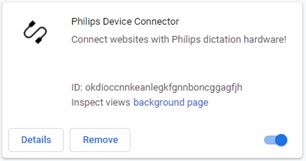
Philips Device Connector native host application
Make sure that you are using the latest version of the Philips Device Connector native host application.
After you successfully installed Philips Device Connector native host application (as outlined above), you can find the application in the following location:
C:\Program Files (x86)\Philips Speech\Philips Device Connector\PDCNativeHost.exe
In addition to that, a registry key is created during the installation process. The key tells the Philips Device Connector Chrome extension where to find Philips Device Connector native host application. Please check if the key was successfully created:
HKLM\SOFTWARE\WOW6432Node\Google\Chrome\NativeMessagingHosts\com.speechexec.devices
Philips Device Connector native host application can generate logfiles if C:\Program Files (x86)\Philips Speech\Philips Device Connector\PDCNativeHost.ini is configured accordingly.
Here is an example for full debug logging:
[LOGInitSettings] Enable=yes File=[Path with write access]\PDCNativeHost.log MaxLines=10000 LogParams=yes LogComments=yes LogVariables=yes Timeout=2000 WrapAtMax=no UseOutputDebug=no FilterFunctions=no FilterVariables=no FilterComments=no
If you need to stop the native host application during troubleshooting, you can find and end the PDCNativeHost.exe in the Task Manager.
 Caution
Caution
If old Philips Speech server extension drivers are installed on this machine (e.g. if you already installed Philips Device Connector before), make sure you uninstall them.
The best and safest way to do that is by downloading Philips Speech Extensions package and running \3_SDK_upgrade_patch\registered\philips_sdk_upgrade.exe
By running philips_sdk_upgrade.exe a multitude of factors are checked and executed:
Old Philips Speech server extensions are removed.
All registered Philips Hardware SDK components are upgraded.
These new components inherently contain the server side control extensions (for buttons and LEDs) and auto-detect whether you´re running Citrix, VMware, WTS/RDP or locally. The local use case is detected in case no Philips client extensions are installed, which might be useful in case of full USB redirection.
Note
If other software relying on old Philips Speech server extensions is running on this machine, philips_sdk_upgrade.exe might break Philips dictation device related remote session functionality of that software under following circumstances:
That other software is integrating Philips Hardware SDK (e.g. SpeechMike SDK) and
Philips Hardware SDK is integrated by that other software in a side-by-side fashion and
Philips Hardware SDK´s version used by that other software is lower than 4.4.441
You would notice that in such a software, button events would not arrive anymore (among other Philips dictation device related functionalities). You can fix this by following these steps:
Find the installation path of the other software. Locate folders named
Philips.SpeechMikeorPhilips.DPMControlor both right next to the application´s executable.Copy files from
\3_SDK_upgrade_patch\sxs\[bitness]\[used SDK]to the respective folders. The bitness must match the other software´s bitness.
For Enterprise environments, it´s possible to run philips_sdk_upgrade.exe via command line. The following parameters are supported:
Parameter | Description |
|---|---|
| Silent installation (no UI) |
| Uninstall |
| Repair |
| Log combined setup. This is path to a file. The folder must exist. |
| Log embedded setups. This is a path to a folder. The folder must exist. The embedded setup for the 32 bit components logs to "{100D881C-DF57-4F34-AD13-F7D6091B6B3B}.log" The embedded setup for the 64 bit components logs to "{700565C9-248D-46D7-AD5F-D3AC8F62D203}.log" The embedded setup for the SpeechAir SDK upgrade logs to "{7C9D3AC6-3674-4F3C-9CF4-BBABB21F57B4}.log" |
Note
If philips_sdk_upgrade.exe run via command line does not find any Philips components to be upgraded, it will not install anything and exit.
 Client
Client
Philips Speech Extensions are supported on many different clients, choose the one matching your environment:
Windows clients
From the Philips Speech Extensions package, run \2_Windows_clients\philips_client_extension_setup.exe.
philips_client_extension_setup.exe automatically installs all Philips client extensions required for your specific client platform, regardless if it´s 32 or 64 bit, or if you're using Citrix, VMware or WTS/RDP.
Note
If you´re running Citrix, it is required to install the Citrix Receiver/Workspace app prior to
philips_client_extension_setup.exe.Do not install Philips client extensions if you configured your virtualization platform (Citrix, VMware…) to fully redirect USB devices. The Philips SDKs on the target side will detect missing client extensions and automatically switch to a local use case, which fits the full USB redirection approach perfectly.
Only when DPMs are used: the DPM drive is mounted to
C:\SPSMOUNTon both client and server/target. For changing the mounting paths, use philips_client_extension_setup.exe command line setup.
For Enterprise environments, it´s possible to run philips_client_extension_setup.exe via command line. The following parameters are supported:
Parameter | Description |
|---|---|
| Path to which DPMMounterService mounts the DPM drive on the client |
| Path to which DPMMounterService mounts the DPM drive on the target/server |
| Silent installation (no UI) |
| Uninstall |
| Repair |
| Log combined setup. This is path to a file. The folder must exist. |
| Log embedded setups. This is a path to a folder. The folder must exist. The embedded setup for the 32 bit components logs to "{ 7B0CAB42-FEAA-43B2-9261-99C4F12F3B42 }.log" The embedded setup for the 64 bit components logs to "{ 50C19A9C-0E96-42F3-9C44-8E72D13F9479 }.log" |
Examples:
Silent setup with default values: philips_client_extension_setup.exe /silent
Silent setup with custom mounter paths: philips_client_extension_setup.exe /silent DPM_LOCAL_PATH="C:\DPM" DPM_SERVER_PATH="C:\DPM"
Linux clients
Please specify which operating system your client is running:
Philips extensions are natively integrated into IGEL OS 10 and IGEL OS 11. Please contact IGEL support for more information about the release plan (which version of Philips extensions is integrated in which version of IGEL OS).
Note
Philips extensions support only Citrix and RDP sessions from IGEL clients.
To enable Philips extensions on IGEL in Citrix environments, go to IGEL Setup -> Sessions -> Citrix -> Citrix Global -> Mapping -> Device Support and checkmark Philips speech channel for dictation.
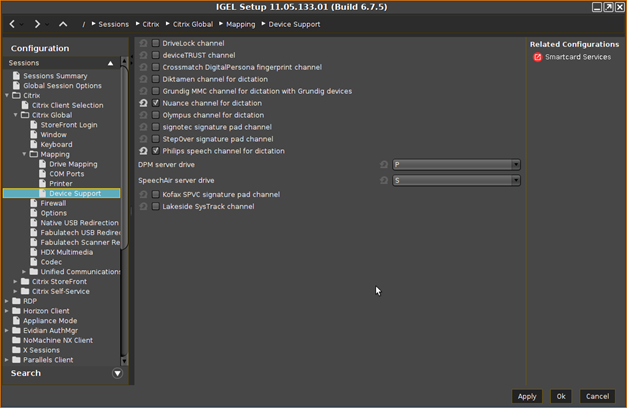
Additionally, if you´re using DPM devices, you can configure the drive mapping right below that checkbox.
To enable Philips drivers on IGEL in WTS/RDP environments, go to IGEL Setup -> Sessions -> RDP -> RDP Global -> Mapping -> Device Support and checkmark Enable Plugin Support and Philips speech channel for dictation.
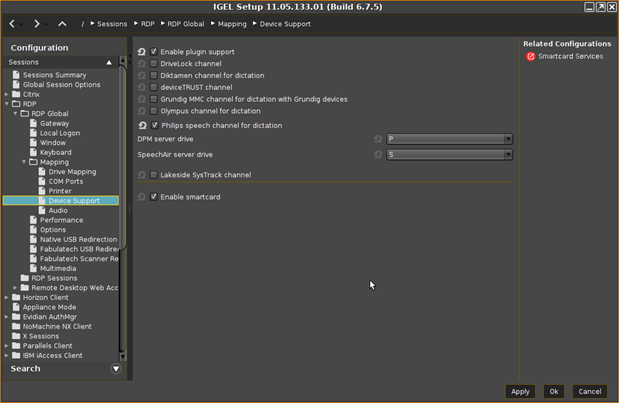
Additionally, if you´re using DPM devices, you can configure the drive mapping right below that checkbox.
Foot control button assignment
For changing the Foot control button assignment, go to IGEL Setup -> System -> Registry -> devices -> philipsspeech
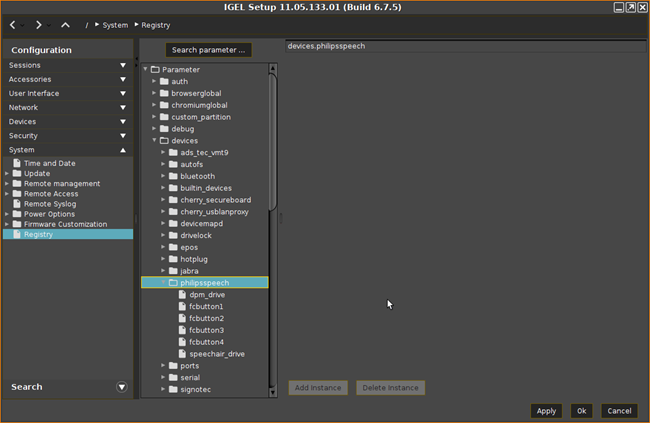
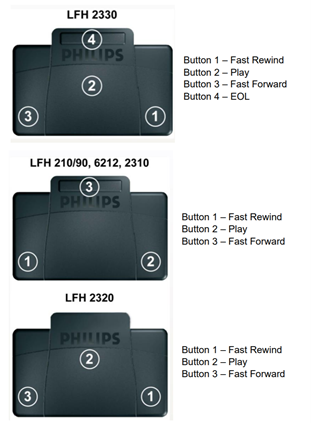
Default values:
Button function | Button | Value Decimal |
|---|---|---|
Fast rewind | 1 | 12 |
Play (Press and Hold) | 2 | 4 |
Fast forward | 3 | 14 |
EOL | 4 | 10 |
Known issues
On IGEL UD3-720 and UD5-720 devices, recording in quality play (dictation.ds2) does not work. There are indications that the cause for that behavior is in the built in audio mixer of the operating system, which takes too much CPU performance.
As only UD3 and UD5 where physically available during release testing it might turn out that other devices face the same issue.
When opening an RDP session on an IGEL UD 5.x client it might happen that DPM related functions do not work properly. This problem is related to the Igel RDP client 2.1. To resolve this issue, open the IGEL setup, go to RDP -> RDP Global -> Options and enable RDP legacy mode:
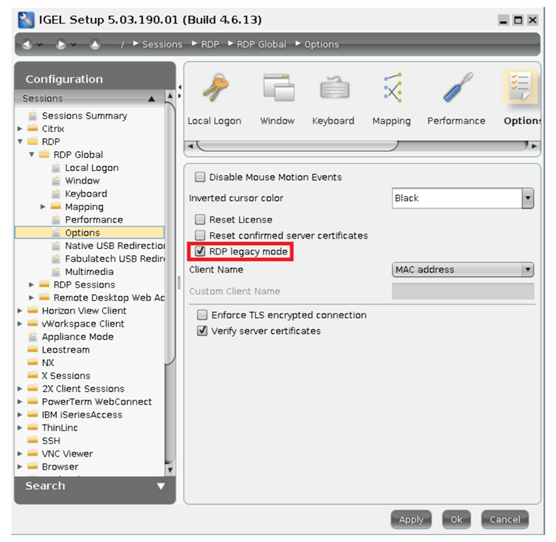
On certain combinations of client hardware and IGEL OS version users have experienced an issue where audio playback in SpeechExec or SpeechSDK integrations would not work and cause an error when no SpeechMike is connected to the client.
We have addressed this issue in version 13.2.3 of Philips client extensions for IGEL OS which are integrated to IGEL OS 11.08.440. The issue can be fixed by enabling Pulse Audio using this registry (Configuration -> System -> Registry) key on IGEL OS: Parameter –> devices –> philipsspeech –> use_pulseaudio.
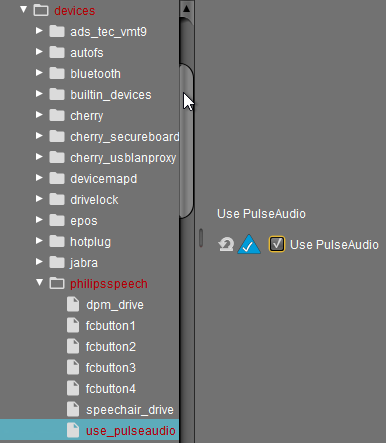
Note
If SpeechExec Enterprise is used in conjunction with Nuance SpeechKit for Speech Recognition in a Citrix session, the Nuance channel for dictation has to be disabled on the IGEL client, otherwise the new Pulse Audio drivers will not work as expected.
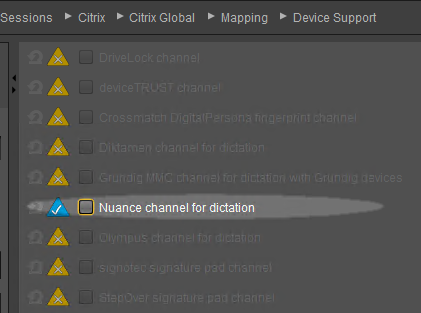
In this case, audio will be redirected to SpeechKit via Citrix HDX.
Note
Philips extensions support only Citrix and RDP sessions from eLux clients.
Please remove all older Philips extensions before installing the new version.
Start the ELIAS tool (can be downloaded from www.myelux.com) and create a new image.
Download the Philips Speech Extensions package and import Philips extensions from the folder
\2_Linux_clients\Unicon.Alternatively, you can download Philips extensions directly from the eLux website www.myelux.com.
Add the Philips extension package to the Defined packages area.
Right-click and activate the protocol you want to use, all additionally required packages (for example, the ICA client) will be added automatically:
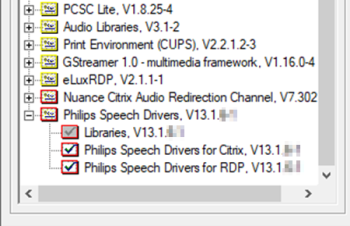
Upgrade the thin clients with the new image.
In Scout Enterprise, ensure that Input USB devices are not muted:
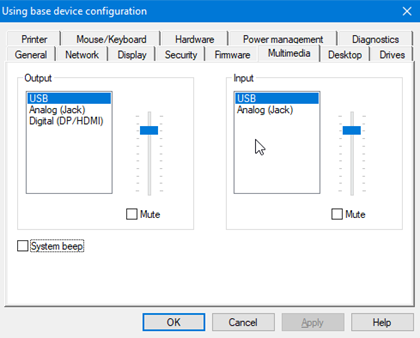
Foot control button assignment
For changing the Foot control button assignment, Change the /etc/PhilipsSpeech/Settings.ini on the client.

Default values:
Button function | Button | Value Decimal |
|---|---|---|
Fast rewind | 1 | 12 |
Play (Press and Hold) | 2 | 4 |
Fast forward | 3 | 14 |
EOL | 4 | 10 |
The Stratodesk noTouch operating system already has the Philips extension drivers implemented, they must be enabled in the configuration menu.
Note
Philips drivers support only Citrix and RDP sessions from Stratodesk clients.
To enable Philips extensions on Stratodesk NoTouch OS in Citrix environments, go to System configuration -> Connections -> <your Citrix connection> -> Citrix -> Citrix Workspace App -> Dictation device/SpeechMike driver and select Philips.

To enable Philips extensions on Stratodesk NoTouch OS in RDP/WTS environments, go to System configuration -> Connections -> <your FreeRDP connection> -> FreeRDP -> Dictation device/SpeechMike driver and select Philips.

Foot control button assignment
For changing the Foot control button assignment, Change the /etc/PhilipsSpeech/Settings.ini on the client.

Default values:
Button function | Button | Value Decimal |
|---|---|---|
Fast rewind | 1 | 12 |
Play (Press and Hold) | 2 | 4 |
Fast forward | 3 | 14 |
EOL | 4 | 10 |
Note
Philips extensions support only Citrix sessions from Ubuntu clients. VMware or WTS/RDP is not supported.
Philips Speech extensions are supported and tested on Ubuntu 18.04 and Citrix Workspace App, you might run into issues on other versions.
Make sure an ICA Client (version 12.x or newer) is installed.
Download the Philips Speech Extensions package and copy
\2_Linux_clients\Ubuntu\x64\PhilipsSpeechDriversLinuxSetupUbuntu.shto a folder on your client.Make the file executable (
chmod +x)Open a terminal window and check if a
wfclient.iniexists in/opt/Citrix/ICAClient/config(or your installation path) – if not, create one by copying the existing template usingsudo cp /opt/Citrix/ICAClient/config/wfclient.template /opt/Citrix/ICAClient/config/wfclient.iniChange to folder where the
.shfile is locatedInstall the drivers running following command
sudo ./PhilipsSpeechDriversLinuxSetupUbuntu.sh --default_hiddev_dir /dev/usb/ --default_joydev_dir /dev/input/ --ica_dir /opt/Citrix/ICAClientDistribute the updated
wfclient.inias required
Foot control button assignment
For changing the Foot control button assignment, Change the /etc/PhilipsSpeech/Settings.ini on the client.

Default values:
Button function | Button | Value Decimal |
|---|---|---|
Fast rewind | 1 | 12 |
Play (Press and Hold) | 2 | 4 |
Fast forward | 3 | 14 |
EOL | 4 | 10 |
If your Linux system is not IGEL or Stratodesk and it is not listed in section Platforms tested by Thinclient vendors (Supported platforms) , it is very unlikely that Philips Speech Extensions are integrated into the system. In this case, you have the following options to get Philips dictation hardware like SpeechMike or Foot control working on your client:
Check whether your system provides Full USB Redirection or Device Splitting methods and use that to redirect Philips hardware
Try to set up Philips extensions yourself by using (and probably modifying) the Ubuntu script (see Ubuntu)
Ask the client vendor to integrate Philips extensions natively
Note
If you are a Thinclient vendor and you are willing to integrate Philips extensions into your OS/firmware, please contact us via support.speech.com.